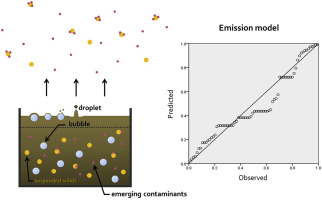Water Research ( IF 12.8 ) Pub Date : 2020-01-09 , DOI: 10.1016/j.watres.2020.115495 Yen-Ching Lin , Ta-Chih Hsiao , Angela Yu-Chen Lin

|
Urban wastewater treatment plants (WWTPs) can be an emission source of aerosol particles to the air and this process has the potential to spread emerging pollutants into the air, where the particles can be widely transported over long distances to areas where this pollution is unexpected. This study demonstrates aeration tanks in WWTPs as a potential source of ketamine, methamphetamine and other emerging contaminant emissions into the air. Ketamine and methamphetamine are frequently detected in high concentrations (maximum of 151.8–162.8 pg/m3) in gaseous and aerosol samples along with 24 other emerging contaminants. Through correlation analysis, the common occurrence of emerging contaminants in air is attributable to their high aqueous concentrations as well as their physicochemical properties. Two simple regression models are developed to provide a practical and convenient way to estimate the steady-state concentrations in air. The gas-phase emission model illustrates the relationship between the solubility, the pKa and the aqueous concentration of compounds in the aeration basin and their gaseous concentrations in air (statistical strength of 74.1%; p value < 0.05), while the partition model establishes the ratio of a compound in the gas and particulate phases in air (statistical strength of 82.6%; p value < 0.05). The results provide a basis for assessing the risk of the inhalation exposure to airborne emerging contaminants; however, in-depth research addressing the impact of aerosols containing persistent pharmaceuticals on human health is still needed.
中文翻译:

城市废水处理厂是向空气中释放氯胺酮和甲基苯丙胺的潜在来源
城市废水处理厂(WWTP)可能是空气中气溶胶颗粒的排放源,该过程有将新兴污染物传播到空气中的潜力,在这种情况下,这些颗粒可以长距离广泛地运输到这种污染无法预料的地区。这项研究表明,污水处理厂的曝气池是氯胺酮,甲基苯丙胺和其他新兴污染物向空气中排放的潜在来源。经常检测到高浓度的氯胺酮和甲基苯丙胺(最大151.8–162.8 pg / m 3),气态和气溶胶样品以及其他24种新兴污染物。通过相关分析,空气中新出现的污染物的常见发生归因于它们的高水浓度及其理化特性。开发了两个简单的回归模型,以提供一种实用且方便的方法来估算空气中的稳态浓度。气相排放模型说明了曝气池中化合物的溶解度,p K a和水浓度与空气中的气体浓度之间的关系(统计强度为74.1%;p值<0.05),而分区模型确定空气中气相和颗粒相中化合物的比例(统计强度为82.6%;p值<0.05)。研究结果为评估吸入暴露于空气中的新兴污染物的风险提供了基础;然而,仍然需要针对含持久性药物的气溶胶对人类健康的影响进行深入研究。


























 京公网安备 11010802027423号
京公网安备 11010802027423号